Abstract
Current tests of vestibular function concentrate on the horizontal semicircular canal-ocular reflex because it is the easiest reflex to stimulate (calorically and rotationally) and record (using electro-oculography). Tests of the other vestibulo-ocular reflexes (vertical semicircular canal and otolith) and of the vestibulospinal reflexes have yet to be shown useful in the clinical setting. Digital video recording of eye movements and vestibular-evoked responses are promising new technologies that may affect clinical testing in the near future.
Full text
PDF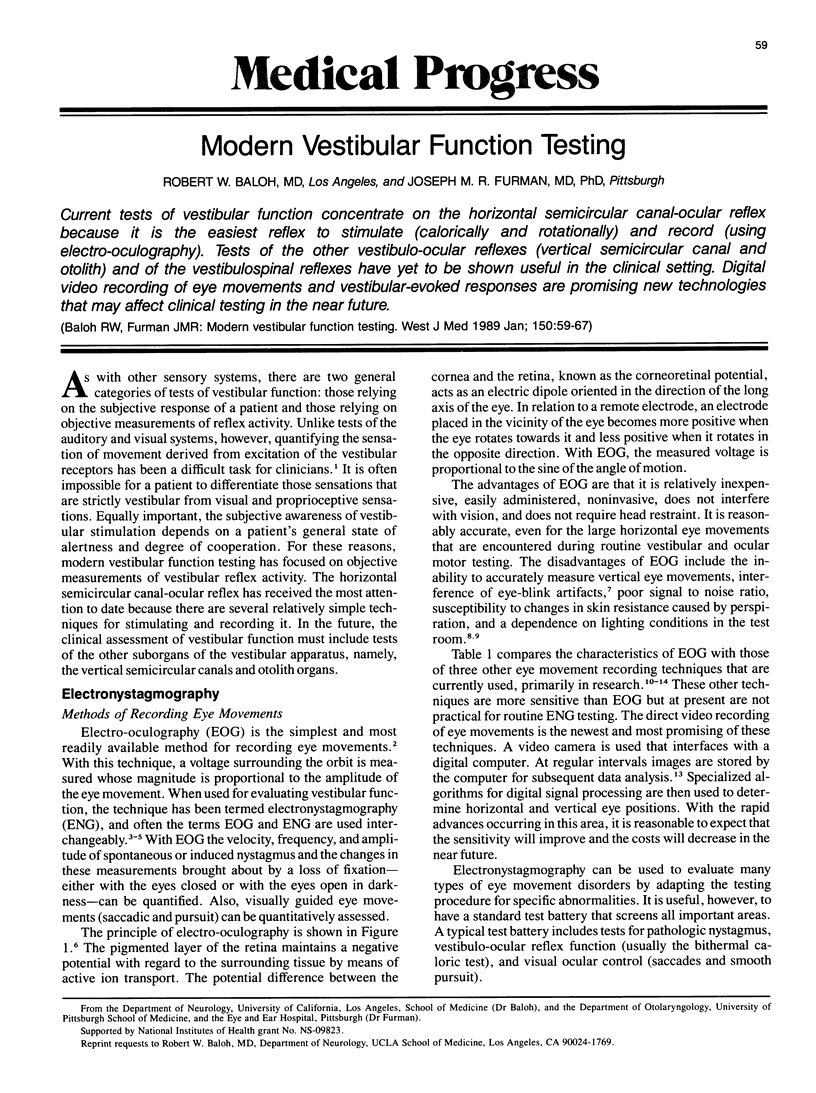
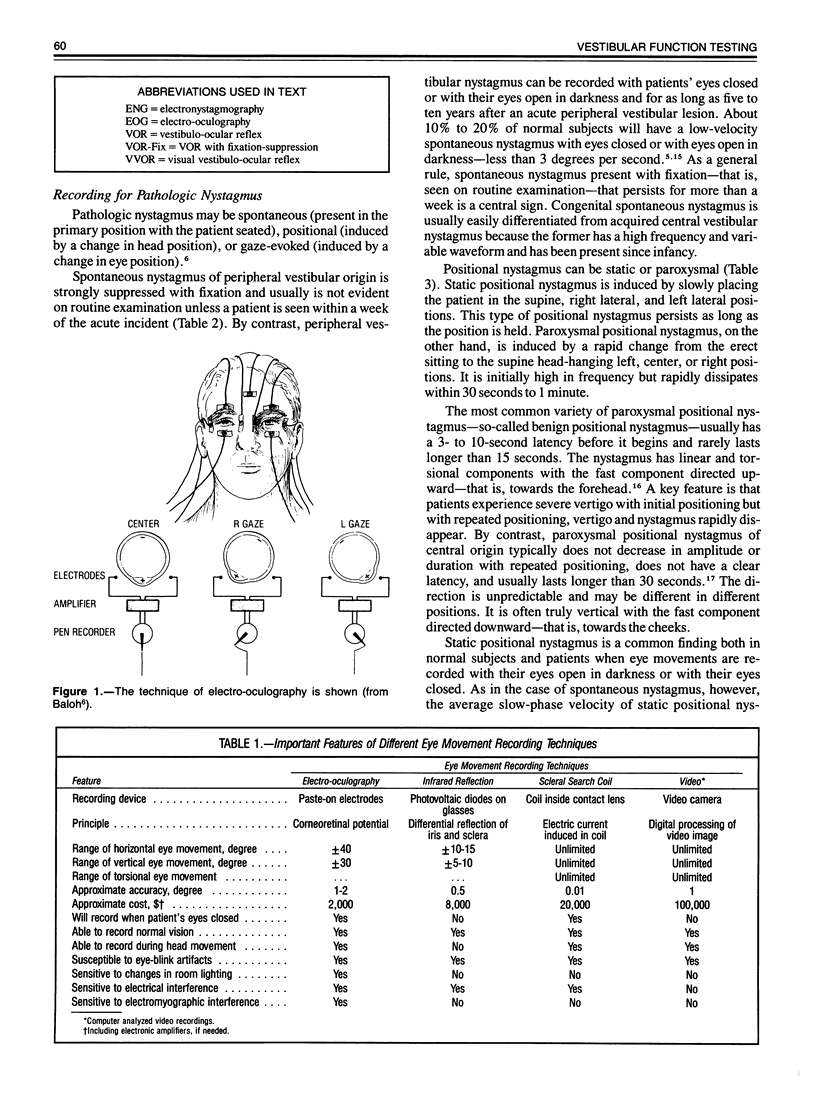
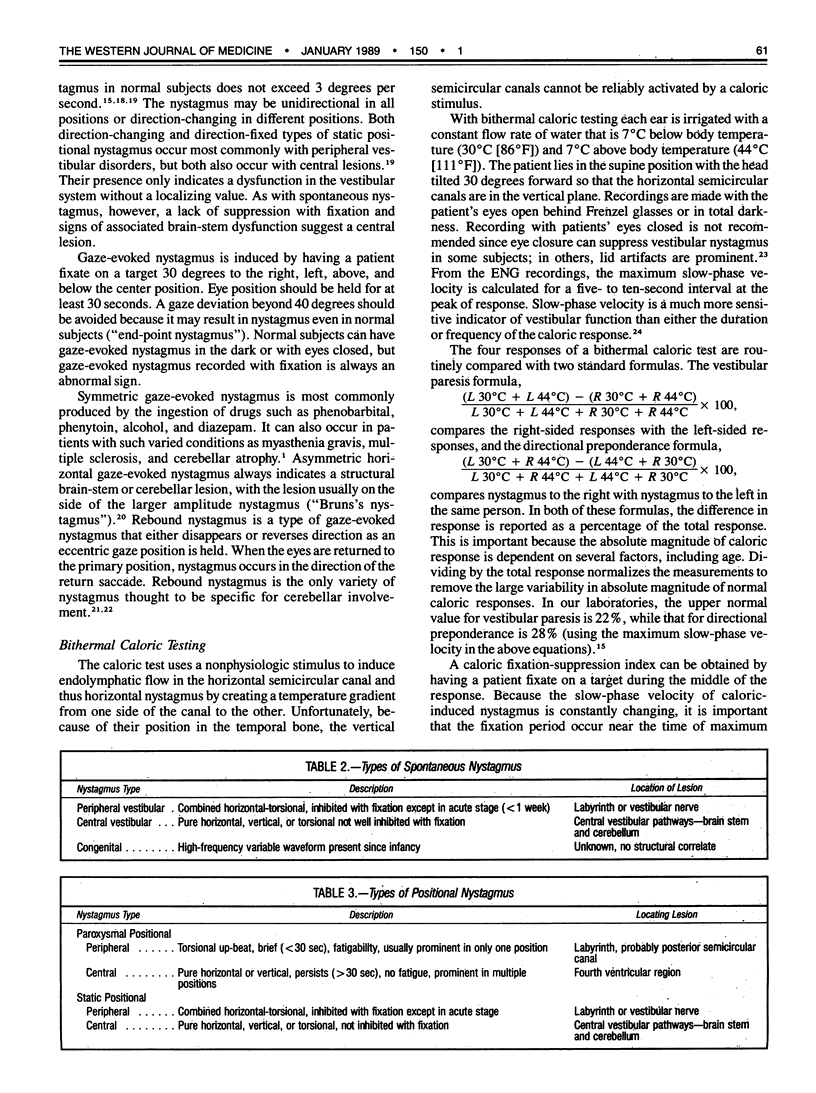
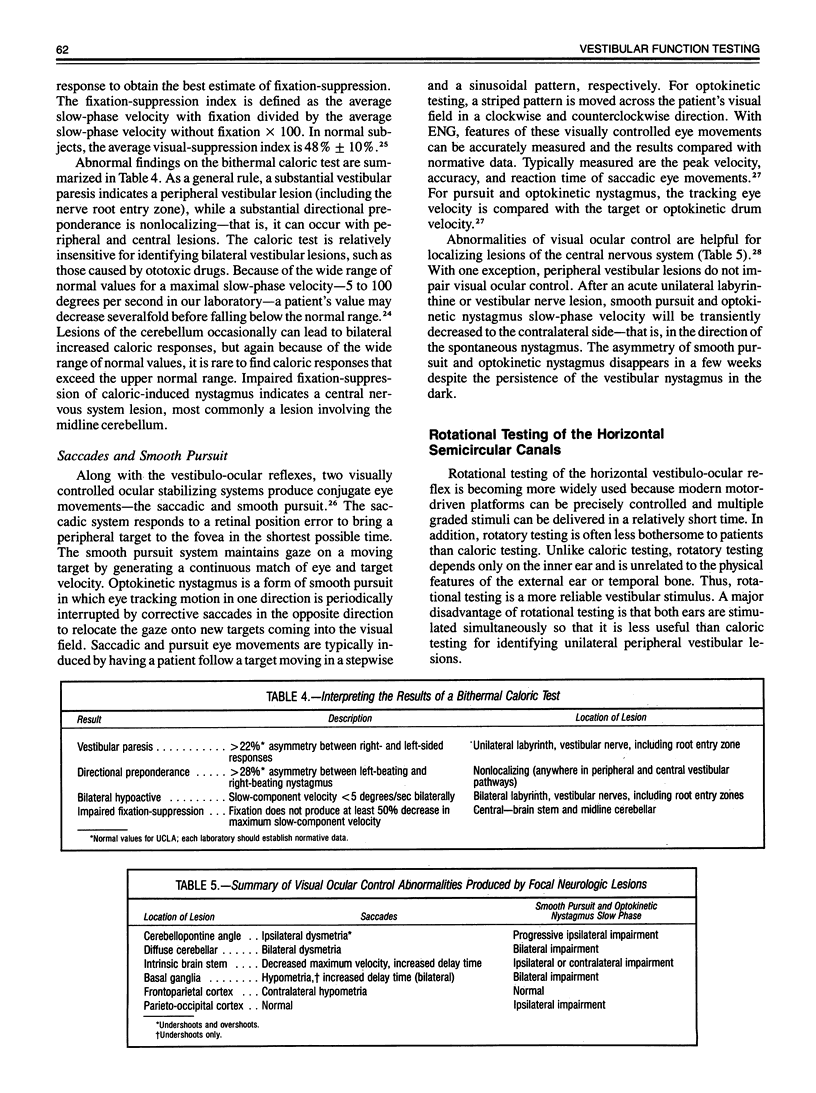
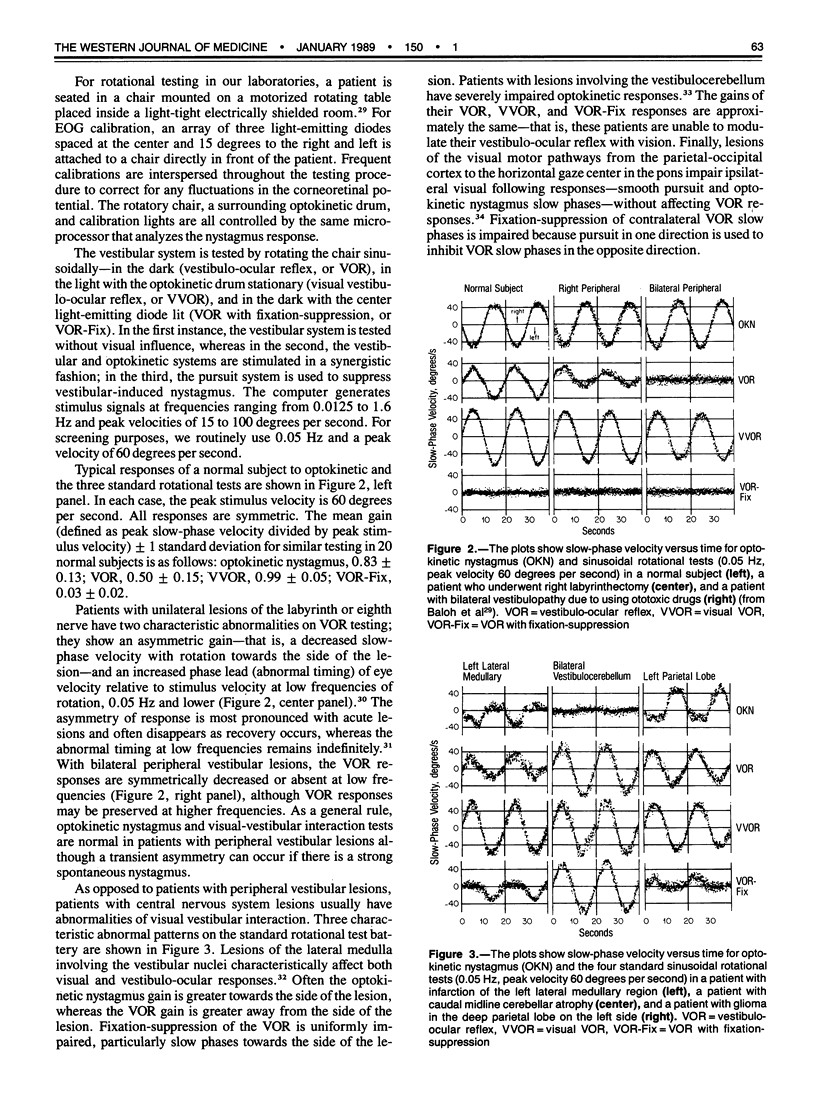
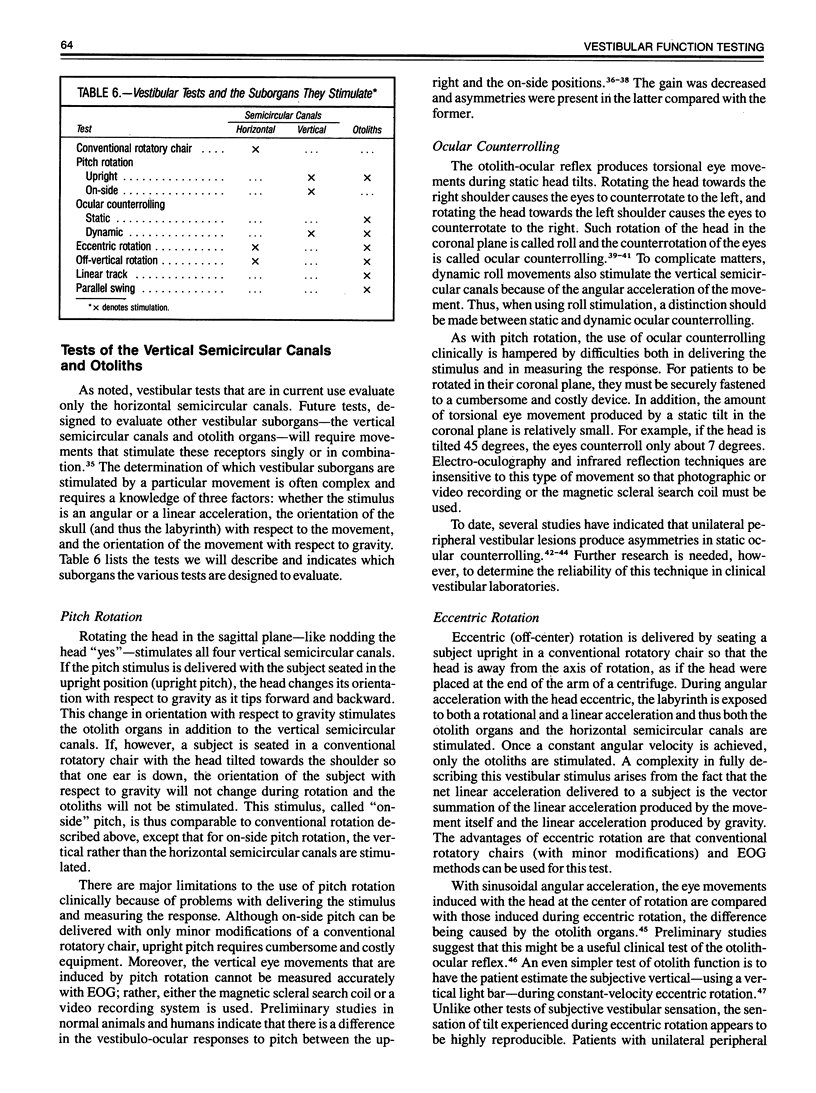
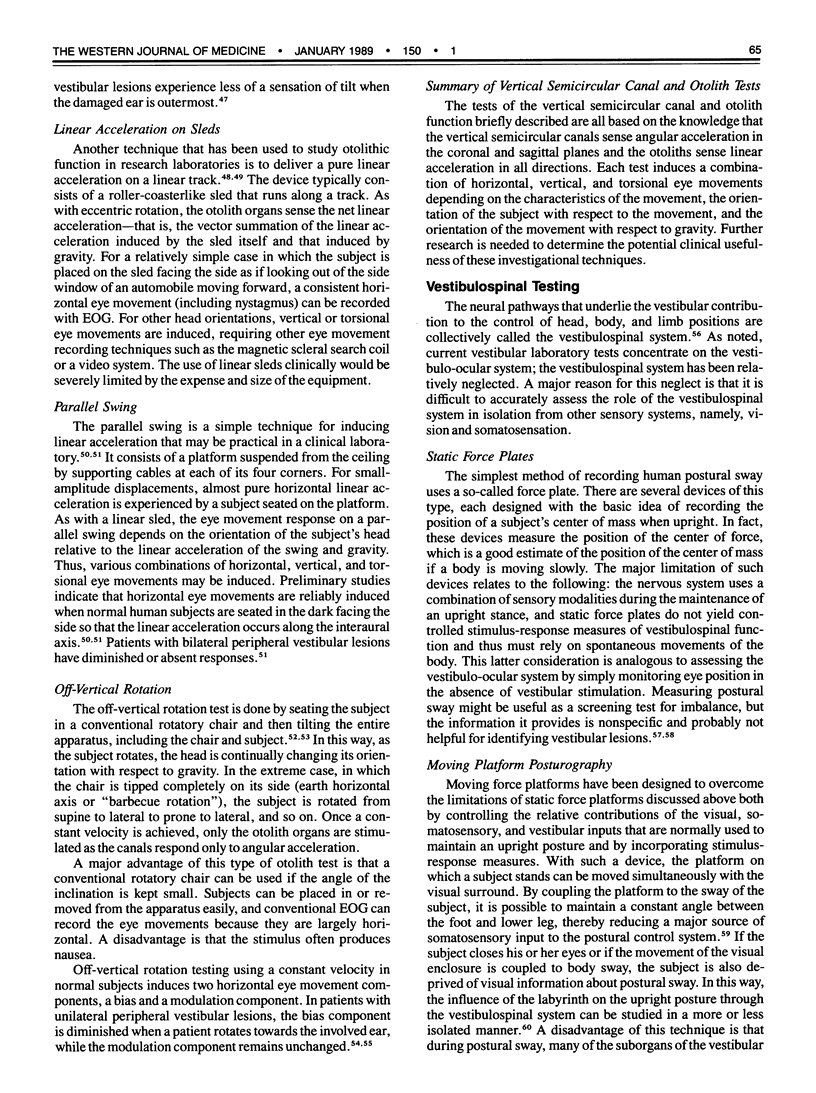
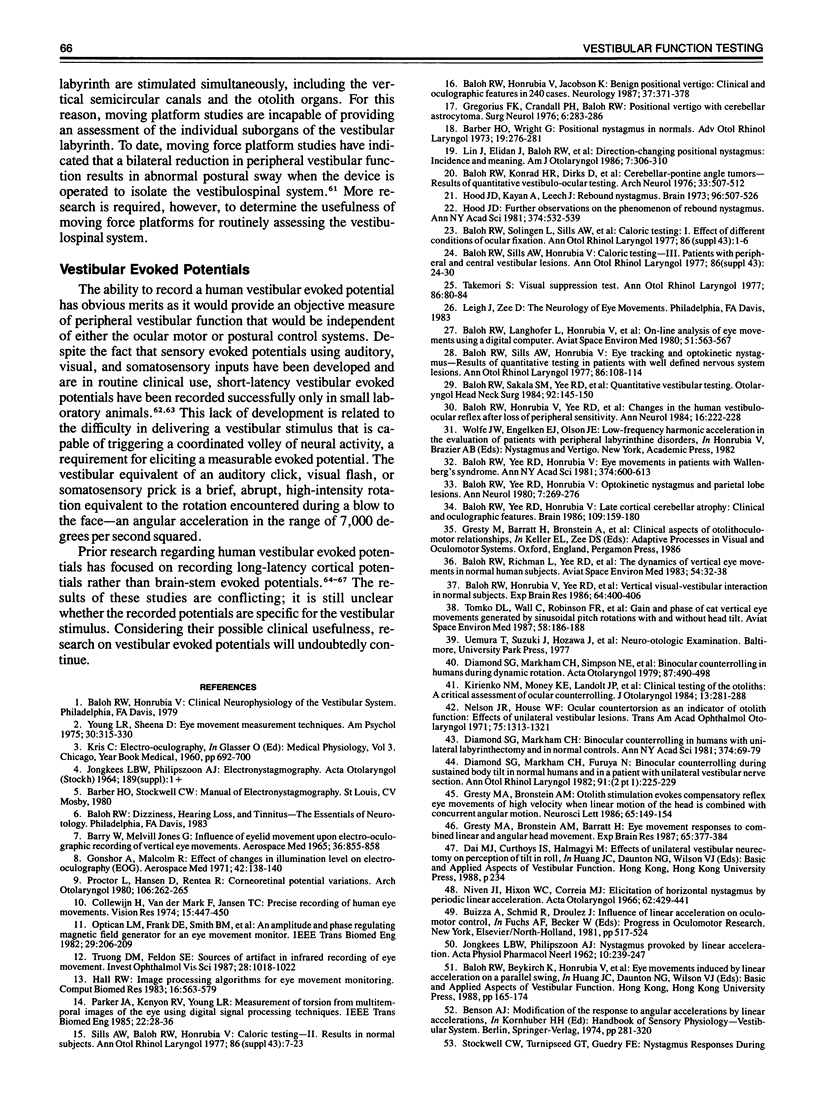
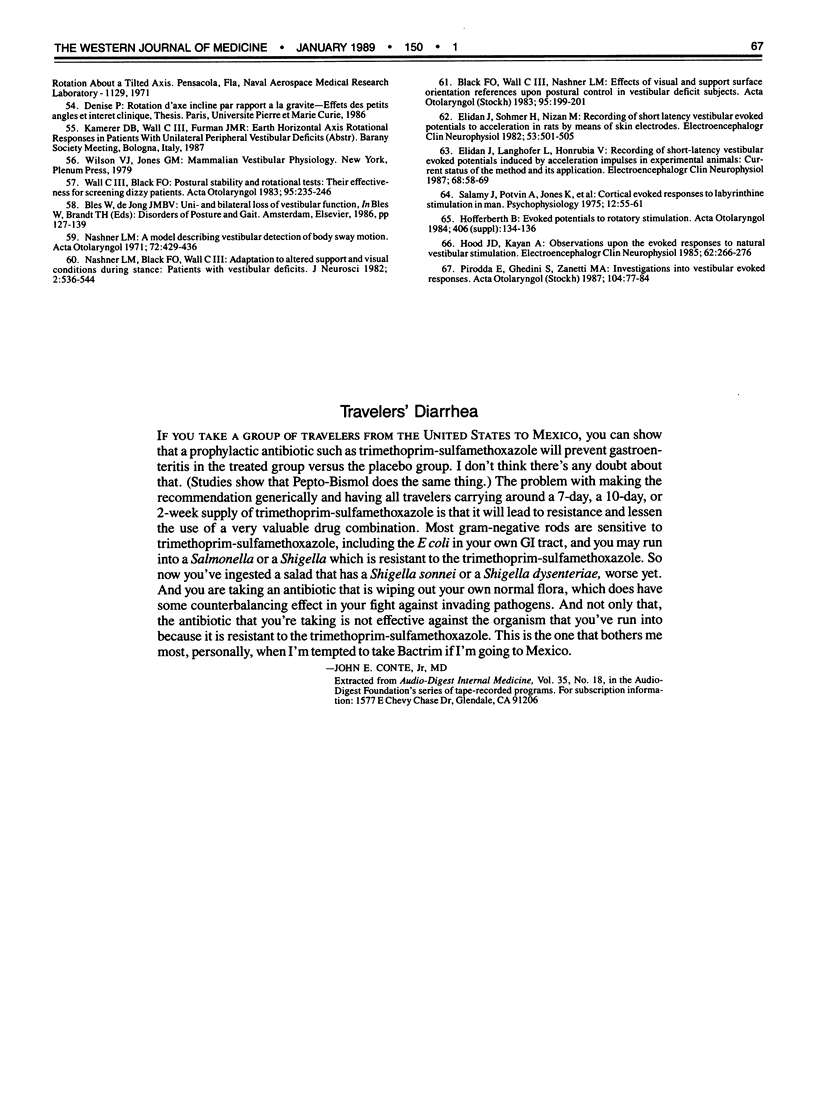
Selected References
These references are in PubMed. This may not be the complete list of references from this article.
- BARRY W., JONES G. M. INFLUENCE OF EYE LID MOVEMENT UPON ELECTRO-OCULOGRAPHIC RECORDING OF VERTICAL EYE MOVEMENTS. Aerosp Med. 1965 Sep;36:855–858. [PubMed] [Google Scholar]
- Baloh R. W., Honrubia V., Jacobson K. Benign positional vertigo: clinical and oculographic features in 240 cases. Neurology. 1987 Mar;37(3):371–378. doi: 10.1212/wnl.37.3.371. [DOI] [PubMed] [Google Scholar]
- Baloh R. W., Honrubia V., Sills A. Eye-tracking and optokinetic nystagmus. Results of quantitative testing in patients with well-defined nervous system lesions. Ann Otol Rhinol Laryngol. 1977 Jan-Feb;86(1 Pt 1):108–114. doi: 10.1177/000348947708600119. [DOI] [PubMed] [Google Scholar]
- Baloh R. W., Honrubia V., Yee R. D., Hess K. Changes in the human vestibulo-ocular reflex after loss of peripheral sensitivity. Ann Neurol. 1984 Aug;16(2):222–228. doi: 10.1002/ana.410160209. [DOI] [PubMed] [Google Scholar]
- Baloh R. W., Honrubia V., Yee R. D., Jacobson K. Vertical visual-vestibular interaction in normal human subjects. Exp Brain Res. 1986;64(3):400–406. doi: 10.1007/BF00340476. [DOI] [PubMed] [Google Scholar]
- Baloh R. W., Konrad H. R., Dirks D., Honrubia V. Cerebellar-pontine angle tumors. Results of quantitative vestibulo-ocular testing. Arch Neurol. 1976 Jul;33(7):507–512. doi: 10.1001/archneur.1976.00500070049010. [DOI] [PubMed] [Google Scholar]
- Baloh R. W., Langhofer L., Honrubia V., Yee R. D. On-line analysis of eye movements using a digital computer. Aviat Space Environ Med. 1980 Jun;51(6):563–567. [PubMed] [Google Scholar]
- Baloh R. W., Richman L., Yee R. D., Honrubia V. The dynamics of vertical eye movements in normal human subjects. Aviat Space Environ Med. 1983 Jan;54(1):32–38. [PubMed] [Google Scholar]
- Baloh R. W., Sakala S. M., Yee R. D., Langhofer L., Honrubia V. Quantitative vestibular testing. Otolaryngol Head Neck Surg. 1984 Apr;92(2):145–150. doi: 10.1177/019459988409200205. [DOI] [PubMed] [Google Scholar]
- Baloh R. W., Sills A. W., Honrubia V. Caloric testing. 3. Patients with peripheral and central vestibular lesions. Ann Otol Rhinol Laryngol Suppl. 1977 Sep-Oct;86(5 Pt 3 Suppl 43):24–30. doi: 10.1177/00034894770865s303. [DOI] [PubMed] [Google Scholar]
- Baloh R. W., Solingen L., Sills A. W., Honrubia V. Caloric testing. 1. Effect of different conditions of ocular fixation. Ann Otol Rhinol Laryngol Suppl. 1977 Sep-Oct;86(5 Pt 3 Suppl 43):1–6. doi: 10.1177/00034894770865s301. [DOI] [PubMed] [Google Scholar]
- Baloh R. W., Yee R. D., Honrubia V. Eye movements in patients with Wallenberg's syndrome. Ann N Y Acad Sci. 1981;374:600–613. doi: 10.1111/j.1749-6632.1981.tb30904.x. [DOI] [PubMed] [Google Scholar]
- Baloh R. W., Yee R. D., Honrubia V. Late cortical cerebellar atrophy. Clinical and oculographic features. Brain. 1986 Feb;109(Pt 1):159–180. doi: 10.1093/brain/109.1.159. [DOI] [PubMed] [Google Scholar]
- Baloh R. W., Yee R. D., Honrubia V. Optokinetic nystagmus and parietal lobe lesions. Ann Neurol. 1980 Mar;7(3):269–276. doi: 10.1002/ana.410070311. [DOI] [PubMed] [Google Scholar]
- Barber H. O., Wright G. Positional nystagmus in normals. Adv Otorhinolaryngol. 1973;19:276–283. doi: 10.1159/000393999. [DOI] [PubMed] [Google Scholar]
- Black F. O., Wall C., 3rd, Nashner L. M. Effects of visual and support surface orientation references upon postural control in vestibular deficient subjects. Acta Otolaryngol. 1983 Mar-Apr;95(3-4):199–201. doi: 10.3109/00016488309130936. [DOI] [PubMed] [Google Scholar]
- Collewijn H., van der Mark F., Jansen T. C. Precise recording of human eye movements. Vision Res. 1975 Mar;15(3):447–450. doi: 10.1016/0042-6989(75)90098-x. [DOI] [PubMed] [Google Scholar]
- Diamond S. G., Markham C. H. Binocular counterrolling in humans with unilateral labyrinthectomy and in normal controls. Ann N Y Acad Sci. 1981;374:69–79. doi: 10.1111/j.1749-6632.1981.tb30861.x. [DOI] [PubMed] [Google Scholar]
- Diamond S. G., Markham C. H., Furuya N. Binocular counterrolling during sustained body tilt in normal humans and in a patient with unilateral vestibular nerve section. Ann Otol Rhinol Laryngol. 1982 Mar-Apr;91(2 Pt 1):225–229. doi: 10.1177/000348948209100222. [DOI] [PubMed] [Google Scholar]
- Diamond S. G., Markham C. H., Simpson N. E., Curthoys I. S. Binocular counterrolling in humans during dynamic rotation. Acta Otolaryngol. 1979 May-Jun;87(5-6):490–498. doi: 10.3109/00016487909126457. [DOI] [PubMed] [Google Scholar]
- Elidan J., Langhofer L., Honrubia V. Recording of short-latency vestibular evoked potentials induced by acceleration impulses in experimental animals: current status of the method and its applications. Electroencephalogr Clin Neurophysiol. 1987 Jan;68(1):58–69. doi: 10.1016/0168-5597(87)90070-0. [DOI] [PubMed] [Google Scholar]
- Elidan J., Sohmer H., Nizan M. Recording of short latency vestibular evoked potentials to acceleration in rats by means of skin electrodes. Electroencephalogr Clin Neurophysiol. 1982 May;53(5):501–505. doi: 10.1016/0013-4694(82)90062-1. [DOI] [PubMed] [Google Scholar]
- Gonshor A., Malcolm R. Effect of changes in illumination level on electro-oculography (EOG). Aerosp Med. 1971 Feb;42(2):138–140. [PubMed] [Google Scholar]
- Gregorius F. K., Crandall P. H., Baloh R. W. Positional vertigo with cerebellar astrocytoma. Surg Neurol. 1976 Nov;6(5):283–286. [PubMed] [Google Scholar]
- Gresty M. A., Bronstein A. M., Barratt H. Eye movement responses to combined linear and angular head movement. Exp Brain Res. 1987;65(2):377–384. doi: 10.1007/BF00236311. [DOI] [PubMed] [Google Scholar]
- Gresty M. A., Bronstein A. M. Otolith stimulation evokes compensatory reflex eye movements of high velocity when linear motion of the head is combined with concurrent angular motion. Neurosci Lett. 1986 Apr 11;65(2):149–154. doi: 10.1016/0304-3940(86)90295-8. [DOI] [PubMed] [Google Scholar]
- Hall R. W. Image processing algorithms for eye movement monitoring. Comput Biomed Res. 1983 Dec;16(6):563–579. doi: 10.1016/0010-4809(83)90042-3. [DOI] [PubMed] [Google Scholar]
- Hofferberth B. Evoked potentials to rotatory stimulation. Preliminary results. Acta Otolaryngol Suppl. 1984;406:134–136. doi: 10.3109/00016488309123020. [DOI] [PubMed] [Google Scholar]
- Hood J. D. Further observations on the phenomenon of rebound nystagmus. Ann N Y Acad Sci. 1981;374:532–539. doi: 10.1111/j.1749-6632.1981.tb30898.x. [DOI] [PubMed] [Google Scholar]
- Hood J. D., Kayan A., Leech J. Rebound nystagmus. Brain. 1973 Sep;96(3):507–526. doi: 10.1093/brain/96.3.507. [DOI] [PubMed] [Google Scholar]
- Hood J. D., Kayan A. Observations upon the evoked responses to natural vestibular stimulation. Electroencephalogr Clin Neurophysiol. 1985 Jul;62(4):266–276. doi: 10.1016/0168-5597(85)90004-8. [DOI] [PubMed] [Google Scholar]
- JONGKEES L. B., PHILIPSZOON A. J. ELECTRONYSTAGMOGRAPHY. Acta Otolaryngol Suppl. 1964;189:SUPPL 189–189:1+. [PubMed] [Google Scholar]
- JONGKEES L. B., PHILIPSZOON A. J. Nystagmus provoked by linear accelerations. Acta Physiol Pharmacol Neerl. 1962;10:239–247. [PubMed] [Google Scholar]
- Kirienko N. M., Money K. E., Landolt J. P., Graybiel A., Johnson W. M. Clinical testing of the otoliths: a critical assessment of ocular counterrolling. J Otolaryngol. 1984 Oct;13(5):281–288. [PubMed] [Google Scholar]
- Lin J., Elidan J., Baloh R. W., Honrubia V. Direction-changing positional nystagmus: incidence and meaning. Am J Otolaryngol. 1986 Jul-Aug;7(4):306–310. doi: 10.1016/s0196-0709(86)80054-0. [DOI] [PubMed] [Google Scholar]
- Nashner L. M. A model describing vestibular detection of body sway motion. Acta Otolaryngol. 1971 Dec;72(6):429–436. doi: 10.3109/00016487109122504. [DOI] [PubMed] [Google Scholar]
- Nashner L. M., Black F. O., Wall C., 3rd Adaptation to altered support and visual conditions during stance: patients with vestibular deficits. J Neurosci. 1982 May;2(5):536–544. doi: 10.1523/JNEUROSCI.02-05-00536.1982. [DOI] [PMC free article] [PubMed] [Google Scholar]
- Nelson J. R., House W. F. Ocular countertorsion as an indicator of otolith function: effects of unilateral vestibular lesions. Trans Am Acad Ophthalmol Otolaryngol. 1971 Nov-Dec;75(6):1313–1321. [PubMed] [Google Scholar]
- Niven J. I., Hixson W. C., Correia M. J. Elicitation of horizontal nystagmus by periodic linear acceleration. Acta Otolaryngol. 1966 Oct-Nov;62(4):429–441. doi: 10.3109/00016486609119587. [DOI] [PubMed] [Google Scholar]
- Optican L. M., Frank D. E., Smith B. M., Colburn T. R. An amplitude and phase regulating magnetic field generator for an eye movement monitor. IEEE Trans Biomed Eng. 1982 Mar;29(3):206–209. doi: 10.1109/TBME.1982.324888. [DOI] [PubMed] [Google Scholar]
- Parker J. A., Kenyon R. V., Young L. R. Measurement of torsion from multitemporal images of the eye using digital signal processing techniques. IEEE Trans Biomed Eng. 1985 Jan;32(1):28–36. doi: 10.1109/TBME.1985.325613. [DOI] [PubMed] [Google Scholar]
- Pirodda E., Ghedini S., Zanetti M. A. Investigations into vestibular evoked responses. Acta Otolaryngol. 1987 Jul-Aug;104(1-2):77–84. doi: 10.3109/00016488709109050. [DOI] [PubMed] [Google Scholar]
- Press F. The suboceanic mantle. Science. 1969 Jul 11;165(3889):174–176. doi: 10.1126/science.165.3889.174. [DOI] [PubMed] [Google Scholar]
- Proctor L., Hansen D., Rentea R. Corneoretinal potential variations: significance in electronystagmography. Arch Otolaryngol. 1980 May;106(5):262–265. doi: 10.1001/archotol.1980.00790290014006. [DOI] [PubMed] [Google Scholar]
- Salamy J., Potvin A., Jones K., Landreth J. Cortical evoked responses to labyrinthine stimulation in man. Psychophysiology. 1975 Jan;12(1):55–61. doi: 10.1111/j.1469-8986.1975.tb03061.x. [DOI] [PubMed] [Google Scholar]
- Sills A. W., Baloh R. W., Honrubia V. Caloric testing 2. results in normal subjects. Ann Otol Rhinol Laryngol Suppl. 1977 Sep-Oct;86(5 Pt 3 Suppl 43):7–23. doi: 10.1177/00034894770865s302. [DOI] [PubMed] [Google Scholar]
- Takemori S. Visual suppression test. Ann Otol Rhinol Laryngol. 1977 Jan-Feb;86(1 Pt 1):80–85. doi: 10.1177/000348947708600113. [DOI] [PubMed] [Google Scholar]
- Truong D. M., Feldon S. E. Sources of artifact in infrared recording of eye movement. Invest Ophthalmol Vis Sci. 1987 Jun;28(6):1018–1022. [PubMed] [Google Scholar]
- Wall C., 3rd, Black F. O. Postural stability and rotational tests: their effectiveness for screening dizzy patients. Acta Otolaryngol. 1983 Mar-Apr;95(3-4):235–246. doi: 10.3109/00016488309130940. [DOI] [PubMed] [Google Scholar]
- Young L. R., Sheena D. Eye-movement measurement techniques. Am Psychol. 1975 Mar;30(3):315–330. doi: 10.1037//0003-066x.30.3.315. [DOI] [PubMed] [Google Scholar]


